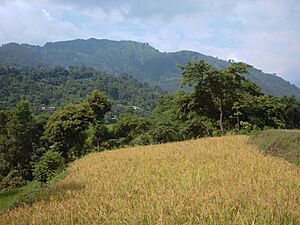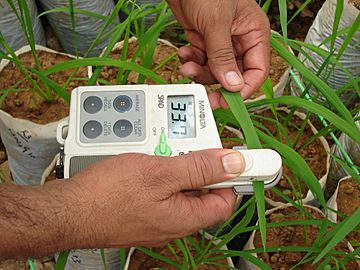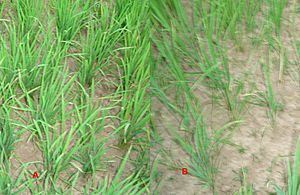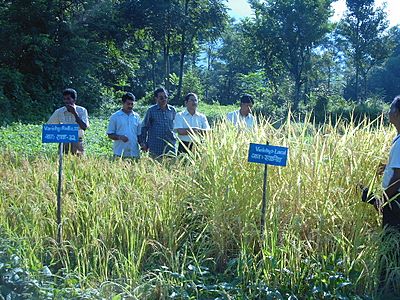Upland rice facts for kids
Upland rice is a special kind of rice that grows on dry land, not in flooded rice paddies. People sometimes call it dry rice.
Millions of people around the world eat upland rice every day. About two-thirds of all upland rice is grown in Asia. Countries like Bangladesh, Cambodia, China, India, Indonesia, Myanmar, Thailand, Nepal, and Vietnam grow a lot of it.
Upland rice grows in fields that rely on rain, just like wheat or maize (corn). These fields can be flat, gently sloped, or even steep hillsides. They can be found at high places, up to 2,000 meters (about 6,500 feet) above sea level. The amount of rain in these areas can vary a lot, from 1,000 to 4,500 millimeters (about 40 to 177 inches) each year.
The soil where upland rice grows can be very good, or it can be poor and acidic. Only a small part of upland rice grows in fertile soil with a long growing season. Many farmers use local types of rice. These don't grow well with lots of modern fertilizers, but they are tough and grow well in their natural environment.
Scientists have studied how to grow upland rice better. They have created new types of rice that can grow in poor soil, fight off pests, and survive dry weather. Some of these new types have produced much more rice than traditional types. Scientists have also mixed these improved types with local ones to create even better hybrid varieties.
Contents
Challenges for Upland Rice Farmers
Farmers who grow upland rice often face many difficulties. They live in areas where it's hard to make a living, and the soil is often not very good for growing crops.
More people living in cities and industries need land. This means there's a lot of competition for land in the uplands. Farmers in the lowlands are also growing more valuable crops, which adds to this competition.
Upland areas have always had problems like dry weather, poor soil, weeds, and plant diseases. For many years, people used "slash-and-burn" farming after cutting down trees. This damaged the soil and caused it to wash away, which also hurt the water sources below.
Because of these pressures, farmers are now trying to grow crops permanently and use their land more intensely. Besides the usual problems, they also need to protect the soil and the many different kinds of plants. They also have to deal with more frequent and serious problems from weeds and diseases.
Fighting the Blast Fungus
Scientists are learning more about how rice plants can resist a disease called blast fungus. This fungus is one of the most harmful diseases for rice. Using special methods, they are creating new types of rice that can fight off this disease better and for longer.
The blast fungus is a big problem in upland areas because the environment there helps it spread. Many traditional upland rice types can resist this disease when farmers don't use many chemicals. However, these traditional types are not good for modern, more intense farming. So, as farming becomes more intense and new rice types are used, the risk from blast fungus goes up.
Scientists from the International Rice Research Institute (IRRI) are working with other researchers to understand the fungus better. They are also looking for genes in some rice types that help them resist the disease. With this knowledge, they are working to combine these genes with other good qualities to create new upland rice varieties.
Researchers are also studying how upland rice farming methods can cause soil to wash away. They want to find ways to stop this erosion. Studies in the Philippines have shown that planting rows of trees, bushes, and grasses along hillsides can reduce soil erosion by up to 90 percent. Farmers can then plant rice or other crops between these rows.
Plants like legumes in these rows can add a lot of nitrogen from the air to the soil. This helps both the rice plants and other crops grow. They also help recycle other important nutrients and organic matter in the soil. These legumes can help farmers earn more money and make farming more sustainable.
The Problem with Weeds
Weeds are the biggest problem for growing upland rice. Scientists at IRRI are working on ways to control weeds using less herbicide (weed killer). One idea is to find rice plants that have a special ability called allelopathy. Allelopathic plants can stop other plants from growing by releasing natural chemicals into the environment. If scientists can find rice plants that stop important weeds from growing, they might be able to create new rice types that can control their own weeds.
Most weed species also get their own diseases. Another way to control weeds could be to use the germs that cause these diseases to attack the weeds among the rice crops.
Researchers from IRRI, Maejo University, and Chiang Mai University started a study in Thailand in 1993. They wanted to understand how weeds, growing conditions, and farmers' methods affect each other. Their goals were to learn about the different ways farmers work and what limits how much rice they can grow.
IRRI scientists are also studying how fertilizers and farming practices affect weed communities. In one project, they are looking at how weed communities change as soil fertility improves over time in the Philippines, Indonesia, and Thailand.
Different types of rice plants are better at competing with weeds in the field. Scientists in the Philippines tested many rice types to see which ones were best at fighting weeds. By planting these strong types and using good farming methods, farmers can reduce how much they need to pull weeds by hand and still get the most rice from their fields.
Making Soil More Fertile
Research on farms in Thailand, Laos, and the Philippines has shown that a lack of phosphorus in upland farms limits how much rice can grow. Scientists suspected this because many old upland soils naturally have low phosphorus and are acidic.
The scientists found that even if farmers add calcium to reduce acidity or plant rice types that can handle acid, a lack of phosphorus will still limit how much rice they can grow. They believe that growing rice and legumes in a cycle could lead to more stable and valuable crops. But first, farmers need to add phosphorus to make sure the soil quality doesn't get worse over time.
Eventually, investing in soil improvements should pay off. The added phosphorus will be more than the crops need, and other nutrients like carbon and nitrogen will be used better.
Breaking the Acid Barrier
The acid in the subsoil (the layer of soil below the topsoil) in many upland areas stops plant roots from reaching water and nutrients. This reduces how much crop can grow. It's not practical to add lime (a substance that reduces acid) to the deep subsoil. But in 1994, IRRI and Indonesian scientists started experiments. They wanted to see if parts of the lime added to the surface could wash down into the subsoil. They are doing this by changing the soil chemistry and using deep-rooted, acid-tolerant rice types to help capture the washed-down lime parts.
Scientists are now studying how fast the lime parts wash down and build up in the subsoil. They plan to use this information to create mathematical models. These models will help them develop practical farming methods and figure out when these methods would work best.
The experiments started at a research site in Sitiung, Indonesia. French scientists are planning similar experiments in Thailand and Vietnam.
Perennial Upland Rice
Rice, like most grain crops, is an annual plant. This means it grows for one season and then dies, and farmers have to replant it every year. This can cause soil to wash away in fields where only one crop is grown. A rice plant that didn't need to be replanted every year could help reduce erosion. It would provide a permanent ground cover and have deeper, stronger roots.
Some wild types of rice from Southeast Asia are perennial (they grow back every year), but they don't produce much rice. However, scientists can cross these wild types with cultivated rice. This could help them develop high-yield rice crops that also grow back every year.
The challenge for scientists is to create a perennial rice plant that produces a lot of rice, grows well in poor upland soils with few added chemicals, and can resist diseases and insects.
Developing high-yield, strong, perennial rice varieties is a big focus at the International Rice Research Institute. New genetic tools allow scientists to transfer the perennial traits into traditional cultivated rice types. They are also using new knowledge about genetic diversity to develop pest resistance.
Helping Farmers Improve Crops
Upland rice is sometimes being replaced by other crops like maize (corn). Also, some traditional types of upland rice are slowly disappearing from farmers' fields. Scientists are using special methods to help farmers keep different types of upland rice while also growing more. Adding upland rice to fields allows for crop rotation and helps make the fields more diverse.





